“No one would have ever predicted that we could turn the cells in our collection into stem cells and that you would be able to clone animals from these (stem) cells; or that you could sequence the genomes of these animals on any kind of scale. At the time when this collection was first banked, the rate of nucleotide sequencing was 10 a year at best. Now nucleotides are being sequenced routinely by my colleagues across the hall.”
- Oliver Ryder, Phd Director of Genetics, San Diego Zoological Society’s Institute for Conservation Research
A “frozen zoo” is a cryonic or “cold storage” facility for the long term preservation of animal and plant genetic material such as skin cells, DNA, sperm, eggs, and embryos. The first facility of this type was developed by San Diego Zoological Society for the study and preservation of genetic material from endangered animal species from across the globe.
The following article is a dialog with Dr. Oliver Ryder, Director of Genetics at the San Diego Zoological Society’s Institute for Conservation Research, home of the San Diego Zoo’s genetics collection. This piece is intended to read as both an interview and a series of vignettes on the background, goals, and highlights of the San Diego Zoo’s genetics collection or “Frozen Zoo”
The Beginnings of the Frozen Zoo and a Benirschke Family Christmas
Mongabay: Dr. Ryder, please tell our readers about the history of the Frozen Zoo and the goals of developing this collection.
Dr. Ryder: Our cell collection or “Frozen Zoo” was started by Dr. Kurt Benirschke in 1975. The collection is as old as the SD Zoo’s in-house research programs. Dr. Benirschke was interested in many subjects; in addition to being an MD, he was an avid conservationist, he was pathologist, a reproductive biologist, and he was very interested in the study of chromosomes as it related to “species barriers and definitions.”
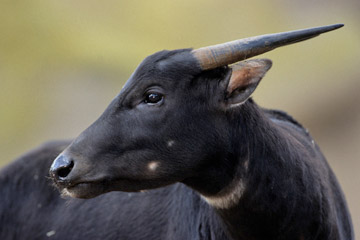 An Endangered Lowland Anoa from Indonesia. Image courtesy of the San Diego Zoo |
Dr Benirschke started the tradition of looking at the genetic d of species, which is now very important to zoos. “Is this a Mountain Anoa or is this a Lowland Anoa? Or is it something completely new?” One of the ways to establish these facts is through chromosomal research. Dr Benirschke was the first scientist to show why a mule is sterile. Everyone knew that mules are sterile. But nobody knew why. Well the chromosomes of a horse and donkey are different and don’t match up in their mule offspring to allow for further reproduction. There is a famous Benirschke family story of how the Benirschkes spent the Christmas Holidays one year cutting out paper chromosome patterns at the holiday dinner table to work out horse and donkey chromosome mechanics (and why they don’t match to produce fertile offspring).
Kurt Benirschke came up with the idea of a Frozen Zoo; we started off with motley collection of samples held in containers of liquid nitrogen. At the time the collection was started we didn’t realize the full ramification of saving genetic material.
The study of genetics is revealing a world much more complex then first imagined: The Bushbucks: One Species or Many?
Mongabay: Has you group ever been surprised by some of the findings study from the study of genetics?
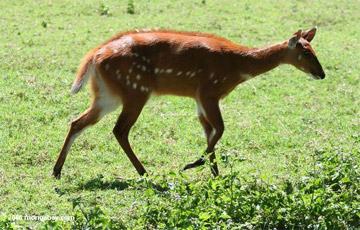 Bushbuck in Uganda. Photo by Rhett A. Butler |
Dr. Ryder: Here is and example of a real surprise in our research: One of the “commonest species” in Africa is the Bushbuck antelope. To this day it is considered a single species across the continent. Well, we get genetic samples from 180 individual institutions; as Bushbuck samples came in from various parts of Africa we noticed the different samples had different numbers of chromosomes. As it turns out, the Bushbuck “varieties” across Africa are very different and not even each other’s closest relatives; with some “Bushbuck types” more closely related to antelope species as the Bongo or Nyala. In the field guides the Bushbuck is listed as “having a very wide distribution and color forms.” Well, they are actually different species; just one of the discoveries made by studying genetic material in the Frozen Zoo.
And though we have relationships with many institutions (to collect material) we get a lot of samples opportunistically. We might get a blood sample of an animal when the vets are handling it or from samples sent in by field biologists. And if we can get some good skin cells we can freeze them in liquid nitrogen and have them growing again in the lab. Our goal was to create a resource for the future through the study of genetics and cell lines, knowing that the newest discoveries aren’t going to end with the paper that came out last month, but may happen much later in time. The Frozen Zoo is like a library of genetics.
Several years ago the San Diego Zoo had the opportunity to take a cell line from a very rare species of parrot:
Birds of a Feather or the Tale of the Spix Macaw Lonely Hearts Club
Mongabay: Dr. Ryder, you have related that the Frozen Zoo has received some genetic samples opportunistically; can your offer our readers an example?
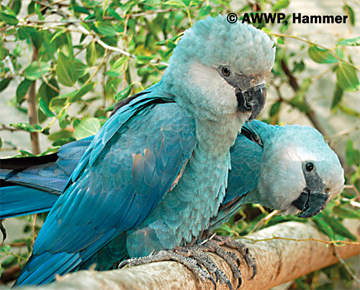 Spix’s Macaw (Cyanopsitta spixii), a species featured in Sheikh goes from collector to conservationist in effort to save the world’s rarest parrot. Image © Al Wabra Wildlife Preservation, Hammer. |
Dr. Ryder: Here is an example: The plight of a very rare parrot was brought to our attention when its private owner could not keep this bird anymore. It had been single macaw living with a bird of another species, an Amazon Parrot. These birds were very close companions and when the Amazon parrot died, the lone macaw had grown to be very unhappy. The owner had decided that the bird would be happier in another situation He knew his pet parrot was very rare, but beyond that not much else. He didn’t even know the sex of the bird. Guessing the importance of this bird, though, he contacted the authorities. A conservation group then called us in conjunction with the Fish and Wildlife Service. “We have a very rare Macaw” that has been brought to our attention, we can’t tell you anything about this bird, but we need for you to help us sex it.” We quickly realized that they were talking about a Spix Macaw.
We used molecular sexing to establish the sex of the bird and an agreement was struck to send this bird back to Brazil to participate in a new captive breeding program. There was one Spix Macaw left in the wild (a lone male) at that point and the Brazilian government was anxious to try to save this species.
Having the opportunity to collect a cell line from a very rare and endangered bird, we told the authorities that we wanted to retain a feather for cell samples; and if a bird is molting it is easy to collect a “blood feather” from a large bird like a macaw. That is how we have our Spix Macaw cell line represented in the Frozen Zoo.
Mongabay: Do you remember if this bird was a male or female?
Dr. Ryder: It was one of the two. (The bird proved to be a female)
Thanks to the efforts of a group of dedicated conservationists, the Spix Macaw may have a reprieve from extinction. Other species represented at the Frozen Zoo, however, haven’t been so lucky: Here Today / Gone Today. The Sad Tale the Po’ouli
Mongabay: Your facility has genetic material of some very endangered animals and even samples from recently extinct species. An example of a recently extinct species represented at the Frozen Zoo is the Po’ouli. Can you tell our readers about this bird?
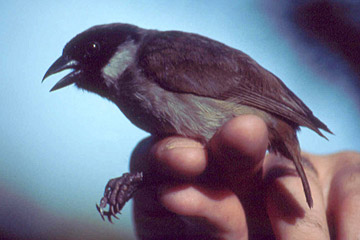 Bird in Hand: One of the Last Po’ouli. Image courtesy of the San Diego Zoo |
Dr. Ryder: The Po’ouli is a sad, sad story. This bird was a unique species of Hawaiian Honeycreeper discovered by college students from the University of Hawaii on a field trip in 1973. A group of biology students and their professor were surveying bird populations in the highlands of Maui. After hiking all day, the group’s professor said “I need to take a rest …Why don’t you (students) go up the mountain and finish the survey.” The students proceeded further “up country” and found birds they could not identify in the field guides; they found a bird species unknown to science. Biologists from the Bishop Museum came out, collected a few birds, and verified their discovery. In Hawaiian tradition a Hawaiian Shaman or “Kahuna” was brought in to help name the bird and the species was called “Po’ouli” which means “black head”.
At that point it was realized that there weren’t many Po’oulis left; maybe a couple hundred? A survey later revealed just twelve birds. “We ought to do something” was the consensus. But nobody could agree on “what something to do.” All this discussion went on over the course of a decade. A group of biologists went back to assess the situation and found just three birds. Finally a decision was made to bring these three remaining birds into captivity, even though their living requirements were unknown and complex. The Po’ouli weren’t seed eaters. They evolved to eat little snails and invertebrates (making them difficult to keep in captivity). By the time the plan was implemented there was one Po’ouli left. They brought the last one in to captivity and when this bird died it was shipped to us immediately. By that time we were prepared to do everything we could to establish a cell line at the Frozen Zoo.
Working with the Po’ouli, I remember thinking “isn’t it a shame, here we are the first people to look at the chromosomes of the Po’ouli, from the last individual of this bird.” This makes a big impression.
Mongabay: How distinct was the Po’ouli?
Dr. Ryder: It was a very important radiation in the family of Hawaiian Honeycreepers. The Hawaiian honeycreepers evolved along the lines of Darwin’s Finches in the Galapagos from one ancestor species into many. Unlike Darwin’s Finches, though, the Hawaiian Honeycreepers have been negatively impacted by introduced disease and many species (of Hawaiian Honeycreepers) are now extinct.
The extinction clock ticks away. Next on the List?
A Tale of Two Rhinos: The Southern and Northern White Rhinoceros.
Mongabay: Please tell our readers about your group’s work with the critically endangered Northern White Rhino.
Dr. Ryder: We have been working with the Northern White Rhino of Central Africa since 1986, but the story of working with this species really goes back to the efforts to save the Southern White Rhino. At the turn of the 20th century the Southern White Rhino was one of the planet’s rarest animals, with less then 50 left in South Africa’s Umfolozi Reserve. Through careful management this population was recovering and it was realized that to further rhino numbers you had relocate animals to new areas. “But how do you move a Rhinoceros? This is the 1960s (limited animal husbandry techniques developed). You don’t put carrots under a box trap with Rhinos.”
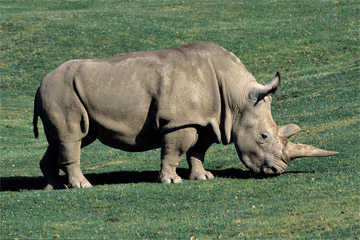 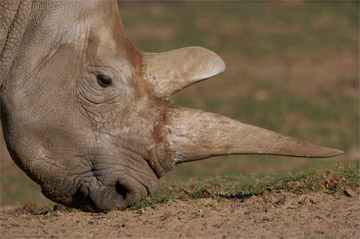 Down for the Count?: The Critically Endangered Northern White Rhino Formerly from Central Africa. Images courtesy of the San Diego Zoo |
A new tranquilizer drug came into development that showed great promise (in working with animals as large as rhinos). Initially sedated (by darting), rhinos could be crated, revived, and shipped to new locations. At about the same time as this translocation project, the San Diego Wild Animal Park was due to open and some of the first rhinos captured in this program were sent to the Park. Our original Southern White Rhinos came in by boat from South Africa. We were wildly successful in working with this species and over a 100 Southern White Rhinos have been bred at the San Diego Wild Animal Park.
The South African organizers of this project became friends of the Zoo. One of the organizers, Ian Player, came to visit San Diego. I was in my lab when I received a call from Kurt Benirschke. “Tell Olly what you told me.” As the problem was related by Ian, “the Northern White Rhino is now on the brink, but people will not put the effort in saving the species if it is basically the same (genetically) as the Southern White Rhino. Are there ways that you can tell if they are different?” We had samples of both rhino types in the frozen zoo. I had a new post-doc in the lab at the time, Matthew George, who is now the Chair of Biochemistry at Howard University. “Matthew, have I got a project for you.” Working with mitochondrial DNA in those days seemed like building the Pyramids by hand, but we took cells of the Northern White Rhine, the Southern White Rhino, and those of the Black Rhino and showed that they were all genetically different from each other. Subsequent work with captive Northern White Rhinos held in a Czechoslovakian Zoo (the only animals available for study at the time), confirmed these results. These findings were published in the “International Stud-book of the Black Rhinoceros” albeit it in German (where the stud book was held).
Consequentially, there was a large effort to save this species in the wild. The Northern White Rhino had existed near the border of Sudan and the Democratic Republic of the Congo, which has been a zone of conflict for decades. A lot of international funding went in to saving the species’ last stand, Garambe National Park. But in the end, the researchers and the security forces protecting the area had to leave due to the unending conflict in the area. Today, the last Northern White Rhinos are in captivity and this population has declined. There is only one reproductive capable female, and the only available (viable) male available is her father. It’s kind of end of the line. Except, there is a good deal of Northern White Rhino genetic material and diversity in the cell lines at Frozen Zoo; we have samples from animals that never reproduced, genetic materials from animals in the wild (etc). In theory, there is enough material available to revive the species but it would take a “heroic effort and heroic technology.”
Mongabay: Would it be possible to implant female Southern White Rhinos with Northern White Rhine embryos?
Dr. Ryder: We are talking with Thomas Hildebrand of the Institute for Zoo Wildlife Medicine in Berlin about a partnership to work with animals like the Northern White Rhino, utilizing our expertise in cell cultures and stem cell technology. Stem cells are much more efficient to work with in cloning animals, and working with Rhinos (and all the associated expense of working with very large animals) efficiency is good. These discussions are very “early stage” and not a solution for the plight of the Northern White Rhino.
A Brave New World?
Mongabay: Could it now be thought that the Frozen Zoo is more then a repository of genetic material but a possible mechanism to revive species?
Dr. Ryder: I don’t like to think that way; it is not an emphasis that I would like to promote. We can use the resources of a genetic collection like the Frozen Zoo to learn more about the needs of species and prevent their extinctions. Hybridization (of domestic animals like cattle with wild relatives), in-breeding, disease are substantial threats to wild animal populations across the planet. Through the study of genetics, we can make more informed decisions about conservation and wildlife management.
It is far better to understand the needs of threatened animal populations at an earlier stage, before it is too late. This position is going to serve us much better then the concept of “waiting until the eleventh hour, and then try pulling these species out of the fire through technology.” Here is a good analogy: Rather then equip lifeboats we should prevent the ships from sinking in the first place.